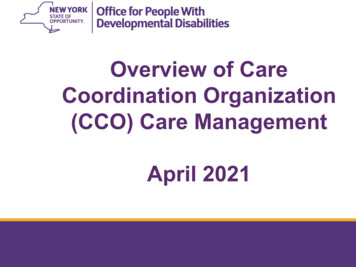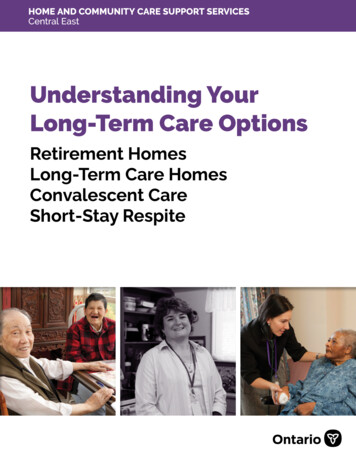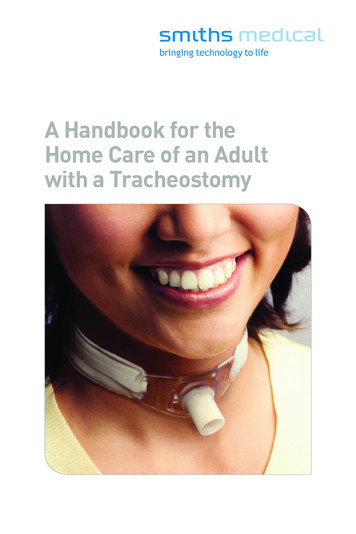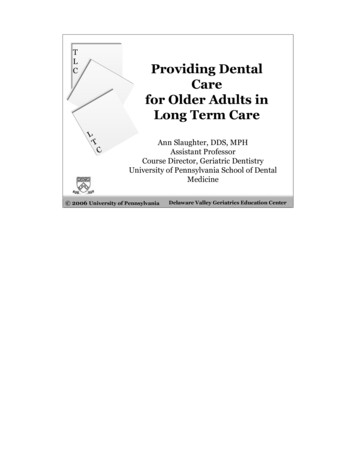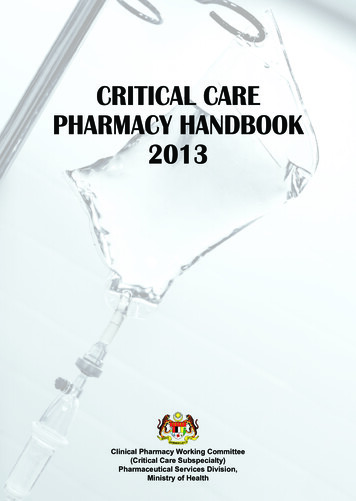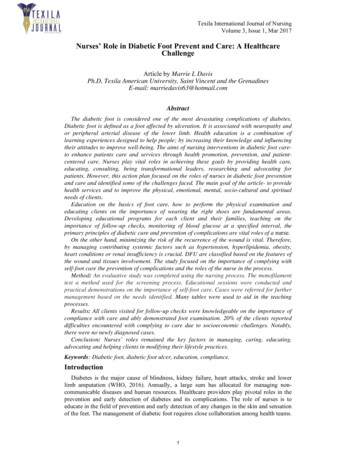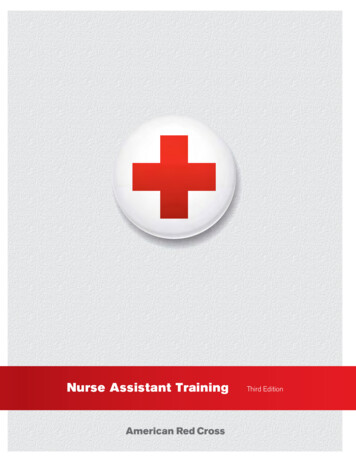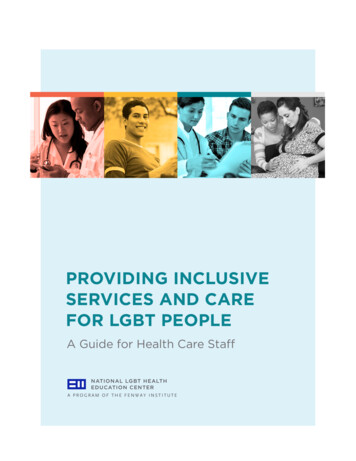
Transcription
PROVIDING INCLUSIVESERVICES AND CAREFOR LGBT PEOPLEA Guide for Health Care StaffN AT I O N A L LG BT H E A LTHE D U C AT I O N C E NT ERA PROGRAM OF THE FENWAY INSTITUTE
Table of ContentsThe Importance of Affirmative and Inclusive Health Care for LGBT People . 1Part 1: Gaining a Better Understanding of LGBT People . 3Concepts and Terms. 3Barriers to Care for LGBT People . 5Limited Access . 5Negative Experiences. 5Lack of Knowledge . 5Common Health Issues Among LGBT People . 6The Challenge of Creating an Inclusive Environment for LGBT People: Two Case Scenarios . 7Part 2: Strategies for Health Care Staff. 8Expectations . 8Practical Thinking . 8Communication Basics . 9Pronouns and Preferred Names. 9What to Do When the Name and Gender on Records Do Not Match . 10Avoid Asking Unnecessary Questions . 10Understand Diversity and Fluidity of Expression . 11Maintaining a Non-Judgmental Attitude . 11Practicing Making LGBT People Comfortable . 11Create an Environment of Accountability . 11We All Make Mistakes, So . 11Putting it All Together - Solving Problems on the Front-lines. 12Conclusion . 13Part 3: Helpful Resources . 15Resources . 16General References . 17Glossary . 18Communication Best Practices . 21i
Providing Inclusive Services and Carefor LGBT People:A Guide for Health Care StaffThe Importance of Affirmative and Inclusive Health Care forLGBT PeopleA visit to a health care facility can make people nervous for any number of reasons. Somepeople may be uncomfortable revealing sensitive information to health care professionals whoneed it to provide certain services. Others find it difficult to talk about private health concerns.Creating an environment in which these conversations are more comfortable for the patient isan important goal for all health care staff. Because health care is for everyone, we must beprepared to serve people of all races, ethnicities, religions, ages, and backgrounds. When peoplehave bad experiences with health care staff simply because they are (or seem) different, theymay hide important information about themselves – or worse, they may not return for neededhealth care.This guide has been developed to help health care staff provide an affirmative, inclusive, andrespectful environment for all clients, with a focus on lesbian, gay, bisexual, and transgender(LGBT) people. Many LGBT individuals have difficulty finding health care where they feelincluded and accepted. Negative encounters can occur with any staff member LGBT peoplemeet, from the time they arrive for a visit until the time they leave. These incidents couldhappen with a security guard, receptionist, nurse, case manager, medical assistant, doctor, orother health care provider. Some LGBT people have reported being refused care because theyare LGBT. Others say they have overheard jokes or slurs, or have received insensitive criticismsabout their appearance or behavior. In many cases, problems arise from simple oversights ormistakes made by well-meaning staff who lack understanding about how to interact with LGBTpeople. For LGBT people who have experienced stigma and discrimination during their lives,even small mistakes can bring up past negative experiences. These feelings can affect theirwillingness to seek health care again. Unless we communicate with knowledge andunderstanding about the health concerns, barriers to care, and other needs that are commonamong LGBT people, they may not get the services they need.LGBT people are very diverse. In addition to being LGBT, they may be any race or ethnicity, richor poor, speakers of English or other languages, and in families that are or may not be religious.All of these factors, and others, can affect their health care experience. In order to provideservices and care to LGBT people in the most effective way, health care staff must be able tounderstand how LGBT people’s identities, experiences, and relationships with the world aroundthem might affect their health. In addition, many non-LGBT people have LGBT family members,and may feel hurt if their family members are not respected. Making LGBT people and their1
families feel safe and included can lead to a more trusting relationship with health careproviders, and improved communication about their unique needs for care.To help all of us provide the health care LGBT people need, this guide will cover LGBT terms andconcepts as well as some common health concerns. It also includes recommended practices forcommunicating with LGBT people, providing them with good customer service, and creating asafe, affirming, and inclusive environment. As we will see, these practices can help providebetter services for everyone else as well.Here’s What You’ll Find Inside: Part 1 provides background information on LGBT people and their health needs. Part 2 provides tips and strategies to improve communication and create a moreaffirming and inclusive environment. Part 3 includes helpful resources, a glossary of terms, and additional informationabout how to care for LGBT people.2
Part 1: Gaining a Better Understanding of LGBT PeopleIn this section, we will introduce basic concepts and terms that may be helpful in developing acommon understanding and good communication with LGBT people. More terms can be foundin the Glossary included in Part 3, Helpful Resources.Concepts and TermsWe begin with two concepts: sexual orientation and gender identity. All people have a sexualorientation and a gender identity. Sexual orientation and gender identity are not the samething.Sexual orientation tells you how a person characterizes their sexual and emotional attraction toothers. Common words to describe sexual orientation are: Heterosexual (straight) is a sexual orientation that describes women who areemotionally and sexually attracted to men, and men who are emotionally andsexually attracted to women. Gay is a sexual orientation that describes a person who is emotionally and sexuallyattracted to people of their own gender. It is more commonly used to describe men. Lesbian is a sexual orientation that describes a woman who is emotionally andsexually attracted to other women. Bisexual is a sexual orientation that describes a person who is emotionally andsexually attracted to people of their own gender and people of other genders.Some people describe their sexual orientation in other ways. For example, some people useterms such as queer, pansexual, same gender loving, or same-sex attracted. Others areattracted to and have relationships with people of the same sex, but prefer to call themselvesheterosexual. This may be because they fear a negative reaction from others, but sometimes itis because their culture does not recognize gay, lesbian, or bisexual sexual orientations. It isimportant to keep in mind that some people desire to be with someone of the same sex, buthave not acted on this desire, and may want to discuss their feelings. Sometimes health care orresearch professionals do not use terms like gay or lesbian to describe people, but focus insteadon their sexual behavior. They use terms like men who have sex with men, abbreviated as MSM,or women who have sex with women (WSW), or use the phrase sexual and gender minorities(instead of LGBT). The glossary in Part 3 defines many of these terms.Later in this document, we will learn how to let LGBT people describe themselves usinglanguage they prefer. This freedom of expression is important, particularly whencommunicating with people from cultures that do not accept gay, lesbian, or bisexual identitiesand may want to use other terms.Gender identity is a person’s internal sense of being a man/male, woman/female, both, neither,or another gender. Most people have a gender identity that is the same as the sex they wereassigned at birth (e.g., a person assigned female at birth and who identifies as a woman).3
However, some people have a gender identity that does not correspond to the sex they wereassigned at birth. We use the term transgender to describe these individuals. The termtransgender describes a wide range of people, including the following: A transgender man is someone who was assigned female at birth and who identifies asa man (some use the term female-to-male, FTM, or transmasculine). A transgender woman is someone who was assigned male at birth and who identifies asa woman (some use the term male-to-female, MTF, or transfeminine). Other people have a gender identity that falls outside of the traditional gender binary ofmale and female. They may identify as both male and female, or as another gender, ortheir gender identity may change over time. Some use the terms genderqueer orgender fluid or something else to identify themselves. Gender expansive perspectivesare increasing among young adults and adolescents.Keep in mind that transgender people can have any sexual orientation, including heterosexual,gay, lesbian, or bisexual. Many use other terms to describe their sexual orientation.Transgender people often transition the way their body looks in order to affirm their genderidentity. For example, many change their name, clothes, hair style, way of walking, etc. Theymay also take cross-sex hormones or have surgery to change the appearance of their bodies tomatch their gender identity. Transgender people may look dramatically different if you knewthem before and after they transition or affirm their gender. Whether you see a person aftertheir transition/affirmation is complete, or in the middle of the process, it is important to berespectful and not to let your curiosity interfere with your professional relationship with anypatient. In addition, recognize that many transgender people do not want to take hormones orhave surgery, so it is important to avoid making assumptions. Also, the surgery and hormonesinvolved in a transition/affirmation are costly and difficult to find, and these treatments taketime to complete.Definitions of terms such as lesbian, gay, bisexual, and transgender are important concepts tolearn. But it is more important to recognize that everyone is unique and deserves to berespected as an individual. Not every LGBT person will fit neatly into one of the LGBT categories.4
Barriers to Care for LGBT PeopleThere are many reasons why LGBT people have difficulty accessing health care. Most of theseproblems can be summarized in three categories.Limited AccessFirst, they may have trouble with basic access to care. LGBT people are less likely tohave health insurance, either because they have been rejected by their families whenthey are young, or because they are unemployed or homeless, or because they requireservices that are not available to them even when they have health insurance.Negative ExperiencesSecond, they may experience discrimination or prejudice from health care staff whenseeking care. Bad experiences with inadequately-trained professionals are a big reasonwhy LGBT people do not seek medical care; many also report that they look for clueswhen arriving at a health care facility, such as the way they are greeted by staff,whether non-discrimination policies are posted in public areas, or if there are singleoccupancy or gender-neutral bathrooms.Lack of KnowledgeThird, LGBT people sometimes discover that providers do not have knowledge orexperience in caring for them. These barriers present a challenge for LGBT individualsand health care staff throughout the nation. The good news is that overcoming themdoes not require extensive training or highly technical expertise.5
Common Health Issues Among LGBT PeopleThere are no LGBT-specific diseases or illnesses. However, LGBT people are more likely toexperience certain health issues compared to people who are not LGBT. These health issues aremostly related to the stigma and discrimination experienced by LGBT people in their dailylives—including at school or work, in public places, or at health care settings. Being a member ofa group that experiences discrimination can cause high levels of stress (sometimes calledminority stress), which can lead to unhealthy coping behaviors and a broad range of healthproblems. For example, an LGBT youth who is bullied by schoolmates may become sociallyisolated and turn to drug use. Other experiences of discrimination can be the direct cause ofhealth issues requiring medical intervention. For example, a transgender person who isphysically attacked. At other times, as we have discussed previously, negative encounters withhealth care staff can interfere with LGBT people’s access to health care.Healthy People 2020 and the Institute of Medicine both describe health disparities LGBT peopleface. A few examples of these health problems include: LGBT youth are 2 to 3 times more likely to attempt suicide, and are more likely to behomeless (it is estimated that between 20% and 40% of all homeless youth areLGBT). LGBT youth are also at higher risk for becoming infected with HIV and othersexually transmitted diseases (STDs). They are also more likely to be bullied. Gay men and other men who have sex with men (MSM) are at higher risk of HIVand STDs, especially among communities of color. LGBT people are much more likely to smoke than others; they also have higher ratesof alcohol use, other drug use, depression, and anxiety. LGBT people are less likely to get preventive services for cancer. LGBT people have higher rates of behavioral health issues. Transgender individuals experience a high prevalence of HIV and STDs,victimization, and suicide. Elderly LGBT individuals face additional barriers to health care because of isolation,diminished family supports, and reduced availability of social services. Some reportdiscrimination from their peers when living in communal elderly housing.By learning to care for LGBT people with sensitivity and understanding, health care workers canhelp LGBT people avoid the “double whammy” of experiencing these health problems in theirdaily lives, and then being discouraged from seeking the care they need.6
The Challenge of Creating an Inclusive Environment for LGBT People:Two Case ScenariosBefore starting Part 2, we present two stories of what might happen at a health care facilitywhere staff are unfamiliar with best practices for managing their interactions with LGBT people.We raise some questions to consider when reading about best practices in communication.Some possible answers to these cases can be found at the conclusion of Part 2.Case: LuisAt the Family Health Center, Luis, a teenage boy, completes an intake form and hands itto Mary, the receptionist. Mary looks over the form and says with a smile to Luis “I’msorry, but we do need you to fill out your mother’s and father’s names. Why don’t youjust tell them to me and I can fill it out for you?” Luis looks away and, in a low voice,says, “I have two dads. Their names are Carlos Montoya and David Sandoval.” Beforeshe can catch herself, Mary becomes flustered and blurts out, “Oh! You don’t have amother?” Mary’s exclamation arouses attention in the waiting area. Luis’s face turns redand he starts heading out the door.What could Mary have done differently to prevent this situation?Case: FlorenceAt the Smithtown Health Center, Charlie has just begun his afternoon shift at the frontdesk. A few minutes after his shift begins, Charlie learns that Dr. Jones is ready for thenext patient. Charlie reaches for the patient’s file, and opens it to find the insuranceform on top. Reading from the insurance form he calls out, “Frank Dubois?” Along witheveryone else in the waiting area, Charlie is surprised to see a woman get up from herchair and approach him. “I’m Florence Dubois, and I believe the doctor wants to seeme,” she says, obviously upset. Charlie is confused, and looks at the patient’s paperworkfor an answer. It takes a few seconds to notice that the clinic’s personal informationform, which every patient provides, is underneath the insurance form. The clinic’s formclearly says “Florence,” but the health insurance form shows “Frank.” Before he canapologize, Florence lets Charlie know how she feels. “You’re just the latest in a series ofpeople who have failed to show me the respect I deserve. I’m a woman and I’mtransgender. I’m tired of having this happen every time I want to see a doctor.”Fumbling for words, Charlie tells her how sorry he is for the mistake, and Florencequickly responds, “I accept your apology. I’ll go with you to see Dr. Jones now.”How did this happen, and what could Charlie have done to prevent such anuncomfortable encounter?7
Part 2: Strategies for Health Care StaffCreating an affirming and inclusive environment in which LGBT people can find trust and opencommunication with their care providers is more than just a good first step. It can go a long wayto improving care, and ultimately the health of LGBT people. The best practices for health carestaff can be summarized in the following broad categories:ExpectationsYou are almost certainly not the first health care staff person an LGBT individual has met. If thepatient has experienced insensitivity, a lack of awareness, or discrimination, they may be onguard, or ready for more of the same from you. Don’t be surprised if an honest mistake resultsin an emotional reaction. Apologizing for your mistakes, or correcting co-workers when theymake one, can help defuse a difficult situation and re-establish a constructive dialogue aboutthe need for care.Practical ThinkingProblem-solving skills can be applied in all interactions with patients. Many of the badexperiences LGBT people have had with health care representatives are similar to those thatwould frustrate anyone. They may not have health insurance or, if they do, they may not understand theircoverage. They may have been unable to express the true nature of their health concerns dueto a lack of trust, or simply because they are nervous about coming to the clinic. They may simply not know how to manage their own care.While you may not be able to solve all of someone’s problems, helping a patient feelcomfortable in what may be a tense time is an important role for health care workers. Referringan uninsured LGBT person to get help enrolling for care, helping a patient deal with billingproblems, making an LGBT patient comfortable with the idea of talking about confidential healthissues, and providing good information about health care options are examples of how to applybasic everyday job skills to improve an LGBT individual’s access to care.8
Communication BasicsUsing the right words can help establish a trusting relationship; the wrong ones can make a badsituation worse by building new barriers to care. At a most basic level, all staff should avoidmaking any assumptions about gender identity and sexual orientation, just as they should avoidassuming racial identity, age, and other characteristics. Other suggestions include: Use the terms that people use to describe themselves and their partners. Forexample, if someone calls himself “gay,” do not use the term “homosexual.” If awoman refers to her “wife,” then say “your wife” when referring to her; do not say“your friend.” It’s OK if this feels awkward to you at first; remember that ourprimary focus has to be on making our patients comfortable. While taking a history, do not use words that assume people have an opposite sexpartner or spouse, or that they have two opposite sex parents. For example, insteadof: “Do you have a boyfriend or husband?” Ask: “Are you in a relationship?” Insteadof: “What are your mother’s and father’s names?” Ask: “What are your parents’names?” Obvious “don’ts” include the use of any disrespectful language, staring orexpressing surprise at someone’s appearance, or gossiping about a patient’sappearance or behavior.Pronouns and Preferred NamesIt is not possible to guess someone’s gender identity based on the person’s name, or how thatindividual looks or sounds. This is true for everyone, not just transgender people. Therefore,when addressing all patients for the first time, avoid using pronouns and other terms thatindicate a gender. For example, instead of asking, “How may I help you, sir?” you can simply ask:“How may I help you?” You can also avoid using “Mr./Mrs./Miss/Ms.” If it is an acceptablepractice in your organization, you can call someone by a first name, or by using the person’s firstand last name together. You can also avoid using a person’s name by tapping the person on theshoulder, making eye contact, and saying, for example, “Excuse me, we’re ready for you now.Please come this way.”It is also important to avoid gender terms and pronouns when talking to others about a newpatient. For example, rather than saying, “he is here for his appointment,” or “she needs afollow-up appointment,” you can say, “the patient is here in the waiting room,” or “Dr. Reed’s11:30 patient is here.” You can also use “they” instead of “she” or “he.” For example, you cansay, “they are here for their 3 o’clock appointment.” Never, however, refer to a person as “it.”Only use gender pronouns if you are certain of the patient’s gender identity and/or theirpreferred pronouns. It is recommended that health care organizations have a system that allowspatients to enter their preferred name, gender identity, and pronouns into registration formsand other relevant documents. This allows all staff to see the patients’ preferences, and to usethem consistently. Creating such a system is helpful for non-transgender patients, too; many9
people might prefer to use nicknames or middle names. Keep in mind that some people usenon-traditional pronouns to refer to themselves, such as they, or ze. Health care staff may needpractice in using these terms.If your organization does not collect information on preferred names or pronouns, it isacceptable to politely ask patients privately what name and pronouns they prefer to use. Forexample, you can say, “I would like to be respectful. How would you like to be addressed?” or,“What name and pronouns would you like me/us to use?” Once a patient has given thisinformation, it is very important for staff to note it in the chart, and use this name in allinteractions. Not using the patient’s preferred name can cause embarrassment and confusion(such as the case mentioned earlier.) If your charts do not have a space for this, talk with youradministrator about how to make the change (see also Part 3’s references and resourcesection).What to Do When the Name and Gender on Records Do Not MatchIn settings that require insurance or use of third-party payers, LGBT patients, particularly thosewho are transgender, often have a name and gender on record that do not match theirpreferred name and gender. Changing one’s name and gender on identity documents andinsurance records can be a complicated and lengthy process. It can be difficult for transgenderpatients to get certain medically necessary treatments if the gender on their insurance doesn’tmatch their anatomy. For example, a male-to-female transgender client requiring prostatescreening can be denied coverage if her gender is recorded on insurance forms as female.Therefore, it is important that staff members are prepared for this possibility, and can ask forinformation without embarrassing or “outing” the patient. This is true even when the source ofthe issue may be outside of your control, as is the case with insurance companies orgovernment agencies. In such cases, it is important to acknowledge that you understand theproblem, know where the responsibility lies for resolving it, and will do everything possible tobe helpful.In a situation where patients’ names or gender do not match their insurance or medical records,you can ask, “Could your chart be under a different name?” or, “What is the name on yourinsurance?” You can then cross-check identification by looking at date of birth and address.Never ask a person what their “real” name is. This could imply that you do not acknowledgetheir preferred name as “real.”1Avoid Asking Unnecessary QuestionsPeople are sometimes curious about LGBT people and their lives, which can lead them to wantto learn more by asking the patient questions. However, like everyone else, LGBT people wantto keep their medical and personal lives private. Before asking any personal questions, first askyourself: “Is my question necessary for the patient’s care, or am I asking it for my owncuriosity?” If for your own curiosity, it is not appropriate to ask. Think instead about: “What do Iknow? What do I need to know? How can I ask for the information I need to know in a sensitive10
way?” If your question falls outside these parameters, you can later educate yourself aboutLGBT people with the resources listed in this guide.Understand Diversity and Fluidity of ExpressionBe aware that there are a wide range of sexual and gender identities and expressions, and thatthese can change over time. For example, some people “come out” later in life, after havingbeen in a long-term heterosexual marriage. Some people do not have a fixed gender identity,and present as different genders on different days. For any number of cultural or personalreasons, some patients may identify their sexuality in a way that does not tell you who theirsexual partners are. People who want to avoid discrimination from their families, friends, or coworkers may call themselves heterosexual, even when they have same-sex partners. Othersmay believe the term “gay” means being effeminate (acting like women), and may not use thisterm to define themselves if they believe they are too masculine for the term to apply. Learningto make patients feel comfortable and trust you enough to reveal such personal information willtake time. Practicing and apologizing for mistakes as you learn will help you develop these skills.Maintaining a Non-Judgmental AttitudeMaking sure patients feel safe and included also means keeping an open mind about differentbehaviors, identities, and expressions. It is also important to avoid showing disapproval orsurprise. Check your body language and facial expressions to make sure you’re not sendingunintended messages. Are you shaking your head “no”? Are you wrinkling your nose? Are youmaintaining eye contact? As we saw with the case of Luis, it is important to always be ready forthe unexpected.Practicing Making LGBT People ComfortableMaking changes in how you greet and interact with patients can be challenging at first. Forexample, most of us have learned to use gender terms like “ma’am” and “sir,” in order to bepolite. However, with practice, you will find it becomes easier. You may find it helpful to postthe Best Practices sheet (found in Part 3 of this learning guide) near your work space. Practicingwith your colleagues can also be helpful.Create an Environment of AccountabilityDon’t be afraid to politely correct your colleagues if they use the wrong names and pronouns, orif they make insensitive comments. Creating an environment of accountability and respectrequires everyone to work together.We All Make Mistakes, So It is not always possible to avoid making errors, and simple apologies can go a long way. If youdo slip, you can say something like: “I apologize for using the wrong pronoun/name/terms. I didnot mean to disrespect you.”11
Putting it All Together - Solving Problems on the Front-linesLet’s return to our stories about Luis and Florence, and explore their experiences from
families feel safe and included can lead to a more trusting relationship with health care providers, and improved communication about their unique needs for care. To help all of us provide the health care LGBT people need, this guide will cover LGBT terms and concepts as well as some common health concerns. It also includes recommended .



